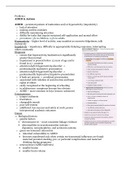Problem 1
ADHD & Autism
ADHD – persistent pattern of inattention and/or hyperactivity (impulsivity)
o lack of attention
o making careless mistakes
o difficulty maintaining attention
o dislike for tasks that require sustained self-application and mental effort
o prevalence: 5% in children, 2.5% in adults
Hyperactivity – higher level of activity, may manifest as excessive fidgetiness; talk
excessively
Impulsivity – impatience, difficulty in appropriately delaying responses, interrupting
others constantly
Diagnosis
o ensure that hyperactivity/inattention is significantly
greater than normal
o impairment is present before 12 years of age and is
found in 2/> contexts
o attention deficit hyperactivity disorder ->
predominantly inattentive presentation
o attention deficit hyperactivity disorder ->
predominantly hyperactive/impulsive presentation
o if both are present -> combined presentation
o associated with violation of social norms and basic
rights of others
o easily recognised at the beginning of schooling
o in adolescence: symptoms become less obvious
o ADHD – more common in boys (reason: unknown)
Consequences:
o temper outbursts
o frustration
o changeable moods
o poor self-esteem
o adulthood: less success and safety at work; poorer
interpersonal academic outcomes
Causes
Þ Biological factors:
o genetic factors
• chromosome 16 – most consistent linkage evidence
• abnormalities in neurotransmitter systems –
dopamine, norepinephrine, and serotonin systems
o genes-environment interaction
• inherited vulnerability to ADHD
• becomes manifested only when certain environmental influences are found:
maternal prenatal smoking, pre- or perinatal complications and maternal
drinking during pregnancy
o neuroscience (ADHD sufferers)
• smaller brains
• smaller brain volume
, • global reduction in grey matter– frontal, parietal, temporal, and occipital
lobes are affected
• decreased volume includes the frontal cortex, basal ganglia, and cerebellum
• deficits in executive functioning (planning, problem-solving), difficulty
inhibiting responses -> controlled by the frontal lobe -> poor performance on
tests of attention, and tasks that require behaviour to be inhibited
• abnormalities in the cerebellum -> choosing, initiating, and carrying out
complex motor and cognitive responses
o prenatal factors
• maternal smoking – prenatal exposure to nicotine caused abnormalities in
the dopaminergic neurotransmitter system, resulting in difficulties inhibiting
behaviour
• drinking during pregnancy
• general complications associated with childbirth
o environmental factors
• biochemical imbalances caused by food additives, lead poisoning, etc.
o heritability – 76%
Þ Psychological factors
o parent-child interactions
• children with ADHD – more likely to be brought up by parents who also have
the disorder => may worsen any symptoms caused by the genetic component
alone -> impatient with the child
• inconsistent, ineffective parenting
o Theory of mind (TOM) deficits
• react inappropriately to family and peers
• ADHD -> poor performance on TOM tasks
• deficits related to planning and inhibition of behaviour -> give rise to
behavioural problems
Treatment
o psychostimulants – increase CNS activity (e.g.: Adderall), produce immediate
and noticeable effects in children
• psychostimulants improve attention and decrease hyperactivity
• less effects on attention and learning
• psychostimulants – do not lead to long-term improvements in behaviour,
learning, and other areas
• side effects: decreased appetite, increased heart rate, and sleeping
difficulties.
o adult ADHD - inattention; impulsivity; overactivity in adults; requires only five
of the six symptoms necessary for the diagnosis in children
o Strattera – nonstimulant medication – treatment of ADHD; prescribed to
adults; less effective than psychostimulants
o Clonidine – can lead to decreases in aggressive behaviour; limited support for
effectiveness
o Antidepressants – justified use only if the psychostimulants fail to work
Article
o Pre-schoolers – parent training is the most appropriate intervention
o School-age children with moderate impairments – group parent training
programmes and classroom behavioural interventions are the most effective
, o School-age children with severe impairments – interventions are more
appropriate when combined with stimulant medication
o Middle school/adolescent children – multimodal interventions. These
interventions usually integrate home and school treatment strategies and often
include an element of social skills training
o Adults – stimulant medication in combination with CBT (Cognitive behavioural
therapy)
Autistic Spectrum Disorder (ASD) – usually
associated with impairment in several areas of
development
o social and emotional disturbances
o intellectual disabilities
o language and communication deficits
o prevalence: 0.05% to 0.2% - increase -> change in
criteria of DSM
Þ impairment of reciprocal social interaction
o in the use of nonverbal behaviours
Þ impairment in communication
o delay in development of spoken language
o inability to sustain a conversation
o echolalia – immediate imitation of words or sounds
that have just been heard
o pronoun reversal – impairment in communication
in which the individual refers to themselves as “he”,
“she”, “you”
Þ impairment in imagination and flexibility of thought
o often display restricted, repetitive, stereotyped
patterns of behaviour and interest
o strong attachment to inanimate objects
Þ intellectual deficits
o intellectual disability, IQ lower than 70 -> in approx. 80% of cases
o perform much better on tests of visuospatial ability than tests of social
understanding or verbal ability
o savant syndrome – extraordinary proficiency in one isolate skill in individuals
with multiple cognitive disabilities
Diagnosis
o deficits in social-emotional reciprocity
o deficits in nonverbal communication (abnormal eye contact)
o deficits in making and maintaining relationships
o symptoms must be present in the early developmental period and must cause
significant impairment in social, occupational, and other areas of functioning
o diagnosing: complicated
• behaviour patterns may change with age
• symptoms may be manifested in varying degrees of intellectual disability
• autistic spectrum disorders are often related to other problems (ADHD,
epilepsy)
Gender
o 80% of those diagnosed are boys




